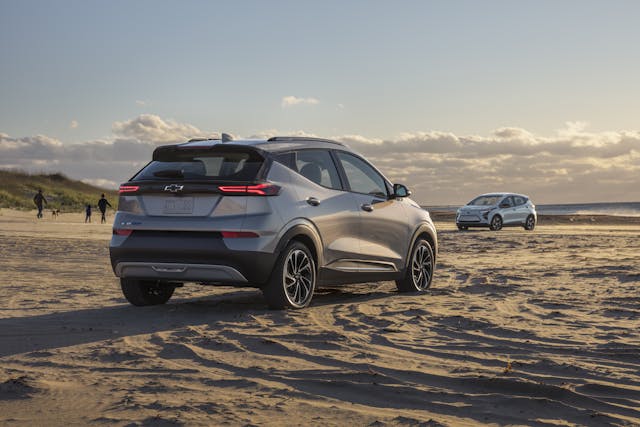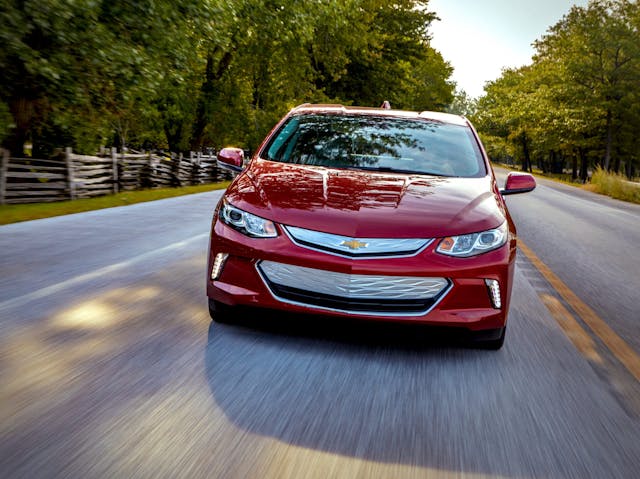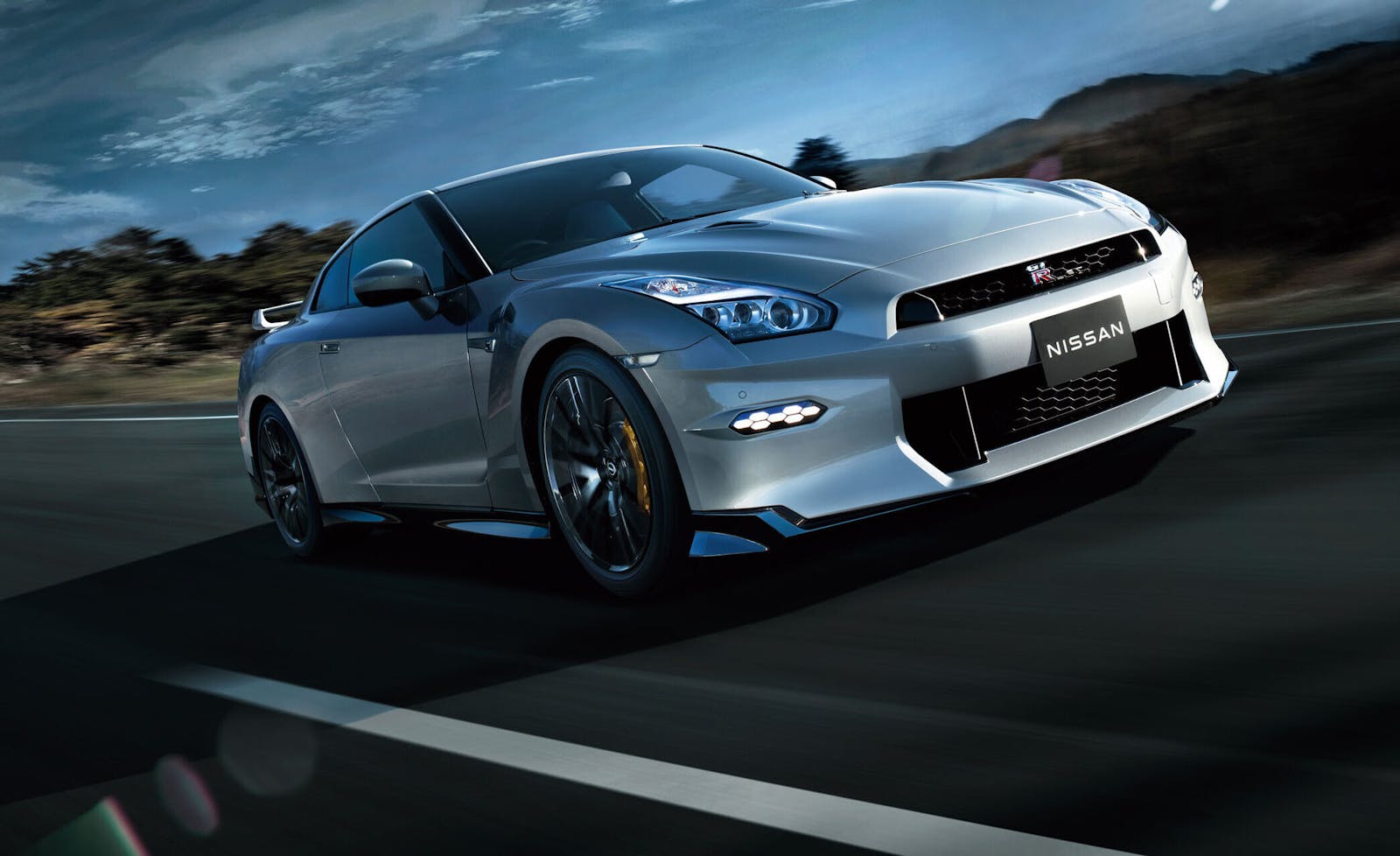Media | Articles
GM CEO Mary Barra: We’re Pivoting Back to Hybrids
At an Automotive Press Association appearance on December 4, 2023, General Motors CEO Mary Barra said GM was considering bringing back hybrids. “We have the technology,” she said. “We’ll continue to look at where the market is, where the regulatory environment is.”
Now, market factors such as customer demand, problems with building electric models, and government pollution standards have caused Barra to admit that GM will begin building plug-in hybrids. Her comments came last Tuesday in a fourth-quarter earnings call with analysts.
She reiterated that GM is still on track to convert its portfolio to all-electric by 2035, as it promised in January 2021, “but in the interim, deploying plug-in technology in strategic segments will deliver some of the environmental benefits of EVs as the nation continues to build its charging infrastructure.”

She declined to say when we’ll see plug-in hybrids, or in which market segments GM will offer them. “We plan to deliver the program in a capital- and cost-efficient way because the technology is already in production in other markets. We’ll have more to share about this down the road.”
It’s lost on no one that GM had a leg up on plug-in hybrids with the Chevrolet Volt, which went on sale in December of 2010. The second-generation Volt, which had an upgraded powertrain and more battery capacity, went on sale in October of 2015. But GM pulled the plug on the slow-selling Volt in 2019 and began doubling down on plans to produce electric vehicles.

GM likely should have further refined a hybrid portfolio, as other manufacturers such as Toyota and Hyundai were doing, rather than dropping the technology altogether. “GM not only had a head-start on hybrids with the Volt but also with the SUVs more than a decade ago,” said Sam Fiorani, vice president for global forecasting for Pennsylvania-based AutoForecast Solutions. “Had they not decided on taking the all-EV route, they could have had a usable, and arguably more popular, hybrid lineup.
Marketplace
Buy and sell classics with confidence
“The emissions regulations are going to require something more than the eventuality of electric vehicles,” he continues. “With the slowing transition to EVs, it makes sense to add hybrids to your lineup, especially since many of your products are V-8-powered trucks, and what are traditionally high-polluting models.”
Also in play is a “slowing of the transition to EVs,” Fiorani said. Early adopters jumped on EVs when they first became available, but the balance of customers have been more cautious about entering the EV market when they perceive that range and infrastructure may not be at the levels they require to abandon their ICE vehicles.

“Everybody anticipated that the growth would continue at this sharp angle, and it’s just not happening,” Fiorani said. “As we transition out of the early adopters, it’s been more difficult to move customers out of their ICE vehicles and into an EV.”
Indeed, simply building EVs and getting them to market has been difficult for GM, in part due to issues with weakened demand and with producing the Ultium battery platform. In a February forecast by AutoForecast Solutions, GM said it planned to build 416,300 EVs in 2023. Actual production was 120,900.
Presently, the Chevrolet Corvette E-Ray is the only hybrid in GM’s North American lineup. As Barra mentioned, GM builds hybrids in other markets, most notably China.

But Fiorani said that simply bringing the Chinese hardware and software here won’t solve GM’s problems. The Chinese hybrids are mostly smaller vehicles, and one issue will be finding a vehicle small enough in the U.S. fleet to use the same technology. “There’s a potential that they could use it in vehicles the size of the Chevrolet Trax, which is produced in South Korea. But the big meat will be hybrids that compete with Ford and Toyota in full-sized trucks.” Both Ford (as of the 2021 model year) and Toyota (as of 2022 MY) currently offer hybrid versions of their full-size trucks, and hybrid offerings in that segment would go a long way to helping GM meet emissions goals across its portfolio.
So when can we expect to see some new hybrids from GM? “This will not be an overnight thing,” Fiorano said, because GM will have to bring back engineering they haven’t used in a decade and raise it to current levels.
“It’s important to note that GM and the rest of the industry should have seen this coming,” Fiorani said, “and should have been better prepared. Toyota, Ford, Honda—a few of these companies have hybrids in their lineup, and companies like Toyota didn’t expect the transition to EVs to happen anytime soon. Something between those two extremes probably would have been the best course of action.”
***
Check out the Hagerty Media homepage so you don’t miss a single story, or better yet, bookmark it. To get our best stories delivered right to your inbox, subscribe to our newsletters.







I hear ya Kelly non of this crap for me I want to smell the gas and exhaust until they put me in a home for yhe criminally insane
How does she keep her job? Where are the board of directors that should be showing her the exit door? Typical car company run by people that are not car people. No direction no leadership.
Meanwhile Tesla is expanding one plant, two more under construction and more in the works and still struggling to keep up with demand. “You changed the whole story, Mary,” Biden said in a November 2021 visit to a GM electric vehicle factory in Detroit. “You electrified the entire automobile industry. I’m serious.”
GM’s proposed shift back to Hybrids–requires a big “DUH!”
Bravo to GM for having a good start towards normalcy. They have gone halfway toward building ICE cars that American consumers want to buy. Now if they could start building something that doesn’t look like an oversized truck, we could be driving a small car that isn’t built in Korea or Japan.
The MARKET must drive the need for EV’s/PHEV’s. NOT the Government. If the current administration continues to force OEM’s to produce them, or if OEM’s continue to increase BEV volume and decrease ICE, they will fail (as what’s going on right now!).
More companies scaling back.
https://www.msn.com/en-us/news/world/the-west-s-humiliating-electric-car-climbdown-has-begun/ar-BB1hGiQ4?ocid=msedgntp&pc=HCTS&cvid=bf7ca4f1cb7f456eab9aa6098bcd5ce4&ei=18
Oh because of the upcoming “emmision regulations”! Your the people that support all the new regulations in the US and Europe to ban ICE vehicles!! You all need to be fired! You should fight the new regulations!
The rush to eliminate fossil fuels is not based so much on science as it is on politics. Research that runs counter to the climate crisis mantra is ignored by the media and dismissed by some scientists who benefit from the hysteria.
EV’s, no gas stoves, no gas water heaters, gas heat…all mandated by government agencies and politicians with an agenda that will enrich them.
Kind of sorry for the rant.
Many things can be said about the GM CEO. That she makes good business decisions is not one of them.
“…does not resolve the issues for the automakers.”
Maybe if politicians worried more about resolving the issues for consumers – not to mention the planet – instead of themselves, we wouldn’t be in this predicament.
But hey, there’s plenty of blame to go around here:
1) GM focuses more on profits and stock price than sales and market share. It’s no secret Wall St. analysts have Mary’s ear and encouraged the move to all EV, just as they’re now telling her “Ooops, maybe we were a bit early on that one.”
2) Chevy’s biggest challenge with EVs is that consumers in its largest markets don’t want them. Look at the markets where Chevy dominates: the Midwest, the South, and all of their employee markets. These folks are not interested in EVs for the most part. Now look where Chevy struggles: the Smile States – where EV adoption is at its highest – and Chevy can’t pay consumers enough to even walk in the door. When the Bolt first came out, Chevy shipped two to every dealer in the country. Want to guess how many of those sent to Heartland America ended-up on the West Coast? I know a West Coast Chevy dealer that was buying Bolts by the truckload from dealers around the country that had no interest in them.
Toyota are not stupid; there’s a reason they’re one of the few manufacturers not rushing to 100% BEVs. That reason is that Hybrids are the most responsible, economical response to mitigating ecological damage TODAY. That may change in the future as alternative technologies mature, but we are obviously not there yet.
Chevy has a couple of nice 3-cylinder turbo engines in their line-up that one hopes could be easily repurposed to power a optional Volt-like power train when each Small and Compact SUV – and maybe Colorado – comes due for its next refresh.
Wasn’t Cadillac going all electric for 2025?